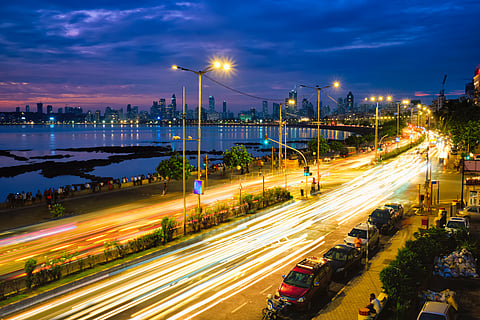
- Destinations
- Experiences
- Stay
- What's new
- Celebrating People
- Responsible Tourism
- CampaignsCampaigns
- SubscribeSubscribe
- Buy Now

In Salman Rushdie's "Midnight's Children," the city of Bombay (now Mumbai) emerges as a city of magic, transformation and history. Among its most iconic symbols stands the Marine Drive, a sweeping arc along the Arabian Sea that encapsulates the city's colonial past in each of its iota. Brimming with architectural grandeur, food and peripatetic culture in scenic promenades and much more, Marine Drive presents what can only be seen as a sack of surprises for a first-time visitor.
Officially called the Netaji Subhash Chandra Bose Road, the Marine Drive was constructed in the early 20th century as part of the British colonial government's Back Bay Reclamation Scheme. This ambitious project sought to expand the city westward by way of reclaiming land from the sea.
What began around 1915 and ended in 1940 was a construction resulting in a 3.6 km long C-shaped scenic boulevard that connected the Nariman Point in the South to Girgaon Chowpatty in the north—a marvel like the nation had never seen before! At night, the streetlights along the curve would be lit and twinkle in resemblance to a string of pearls, subsequently earning its affectionate moniker "Queen's Necklace."
Among the many things that Marine Drive is taken so superiorly is its extensive collection of Art Deco buildings, making Mumbai home to the second-largest concentration of such structures globally, preceding Miami. Constructed between the 1930s and 1940s, these buildings showcase streamlined forms, geometric patterns, nautical motifs, and a dash of late modernity.
Notable examples of Art Deco buildings at Marine Drive include the Kapur Mahal, Zaver Mahal, and Keval Mahal. The area's architectural and urban significance was recognised in 2018 when UNESCO designated the "Victorian Gothic and Art Deco Ensembles of Mumbai" as a World Heritage Site.
While a whole heap can further be delineated about the architectural showcase of Marine Drive, it certainly expands to much more than that: it's a cultural artery pulsating with life.
The promenade is a popular spot among morning joggers, evening strollers, newcomers and those seeking solace by the sea. It's been in several films in Bollywood wherein a character is observed ankling towards the beachfront to sit at the emblematic tetrapods and have a moment of reflection.
At the northern end of the affair lies Girgaon Chowpatty, a beach known for its operatic atmosphere and street food by the sea offering delicacies like bhel puri and pav bhaji, the staple stack of Mumbai. Nearby, the Taraporewala Aquarium, established in 1951, further enhances the gravity of the place as Mumbai's oldest aquarium. It was recently renovated to include modern exhibits.
If you scamper down to the Southern tip of Marine Drive, you'll end up at Nariman Point, Mumbai's premier business district characterised by towering skyscrapers and luxury hotels. This juxtaposition of leisure and commerce epitomises the city's dynamic spirit.
Marine Drive’s silhouette is etched into the collective memory through countless Bollywood scenes—melancholic breakups, long contemplative walks, and the occasional song in the rain. Though the list is far from exhaustible, to name just a few, the spot features in "Wake Up Sid" (during a romantic scene where the characters confess their love in the rain, with the romantic ballad "Iktaara" playing in the background), "Munna Bhai MBBS" (a scene where Munna, played by Sanjay Dutt, sits on the concrete tetrapods along the sea, reflecting on his situation), "Dhoom," and much more.
Literary references are also abound—from Rushdie’s magic realism to the grounded realism of Rohinton Mistry, who situates many of his characters just off this shoreline.
Marine Drive, in essence, a character in its own right.
Marine Drive is the perfect springboard for discovering central Mumbai’s wealth of attractions:
Gateway of India, just 10–15 minutes away at Apollo Bunder, stands as the city’s most famous colonial-era arch, built in 1924 to commemorate the arrival of King George V and Queen Mary.
Chhatrapati Shivaji Maharaj Terminus (CST), formerly Victoria Terminus, is a UNESCO-listed Gothic masterpiece and an active railway station—an essential visit for fans of architecture and Mumbai’s transport chaos.
National Gallery of Modern Art (NGMA) near Colaba presents rotating exhibitions of Indian and international artists in a stately dome-topped structure.
Mani Bhavan, once Mahatma Gandhi’s residence in Mumbai, is now a museum that traces his life and work through photographs, documents, and preserved rooms.
Hanging Gardens and Kamala Nehru Park, atop Malabar Hill, offer panoramic views of Marine Drive from above and are perfect for early morning visits or family strolls.
Bandra Fort (Castella de Aguada), though further away in Bandra West, gives expansive views of the Bandra-Worli Sea Link and offers a quieter, breezier alternative to central tourist spots.
Flora Fountain and Kala Ghoda are art and heritage zones worth walking through. The latter is especially vibrant during the annual Kala Ghoda Arts Festival, showcasing installations, performances, and street theatre.
Marine Drive is easily accessible via public transport, including local trains (Marine Lines and Churchgate stations) and buses.
The promenade is open year-round, but the cooler months from November to February offer the most pleasant weather for walks and sightseeing. While the area is generally safe, standard precautions should be taken, especially during late hours.
